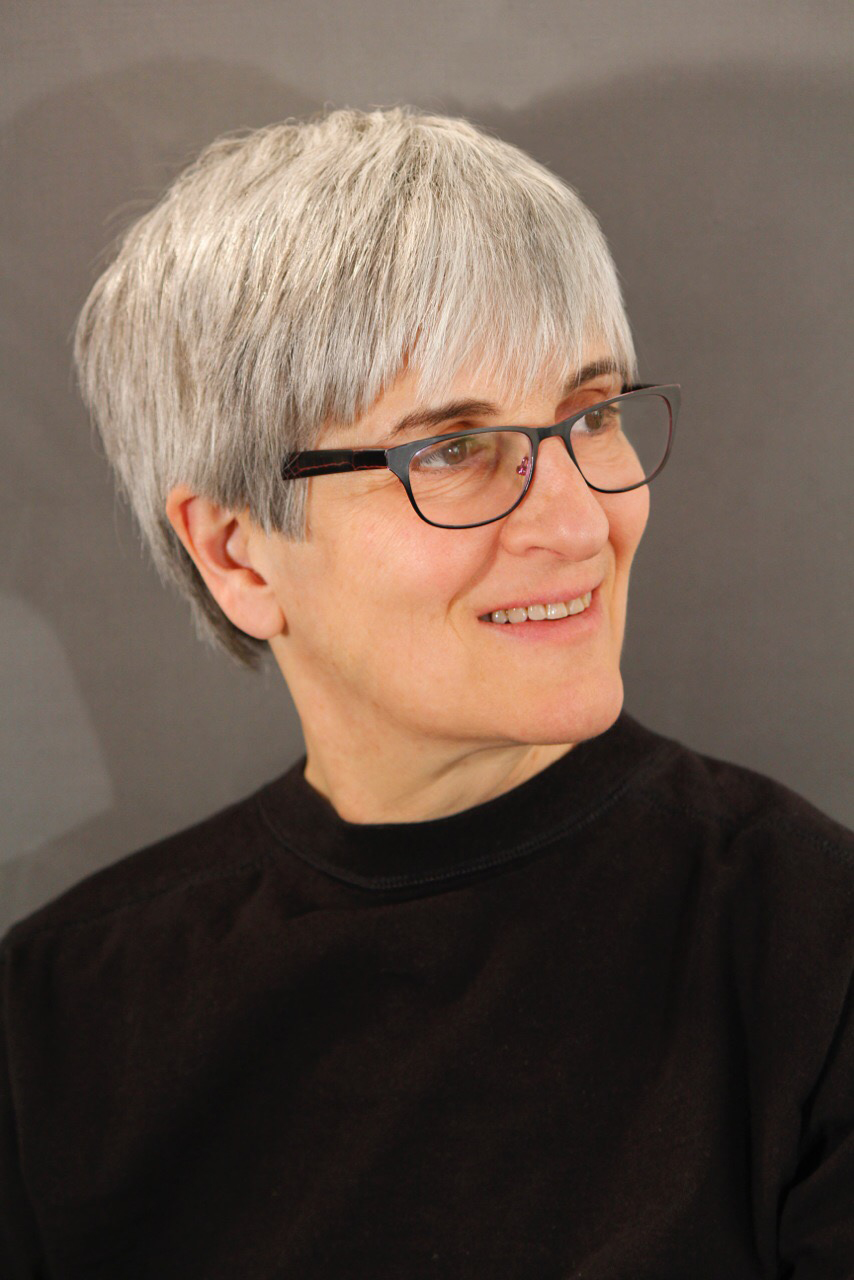Interview
April Katz: The Next Chapter
“The Next Chapter,” is a regular feature in Graphic Impressions that focuses on the lives and work of printmakers who have recently moved into a different phase in their careers.
April Katz received her M.F.A. degree from Arizona State University. She currently is Morrill Professor Emeritus at Iowa State University where she taught printmaking for twenty years. From 2004 – 2006 Katz served as president of the Southern Graphics Council. Her prints, which synthesize digital and traditional printmaking processes, are in numerous collections and have been exhibited throughout the US and in Portugal, Spain, and the Yinchuan Art Museum in China. She has presented papers for print, photographic and visual literacy professional conferences.
As an artist Katz’s primary language and tool is the print. Her vocabulary includes transfers, layers, seriality, and variations on a theme. Death of loved ones, serious illness and political discord are the forces that have shaken Katz to the core and led her to ask fundamental human questions about herself and her relationship to the world. She searches for connections between disparate elements to understand and convey their impact on current personal and cultural identity.
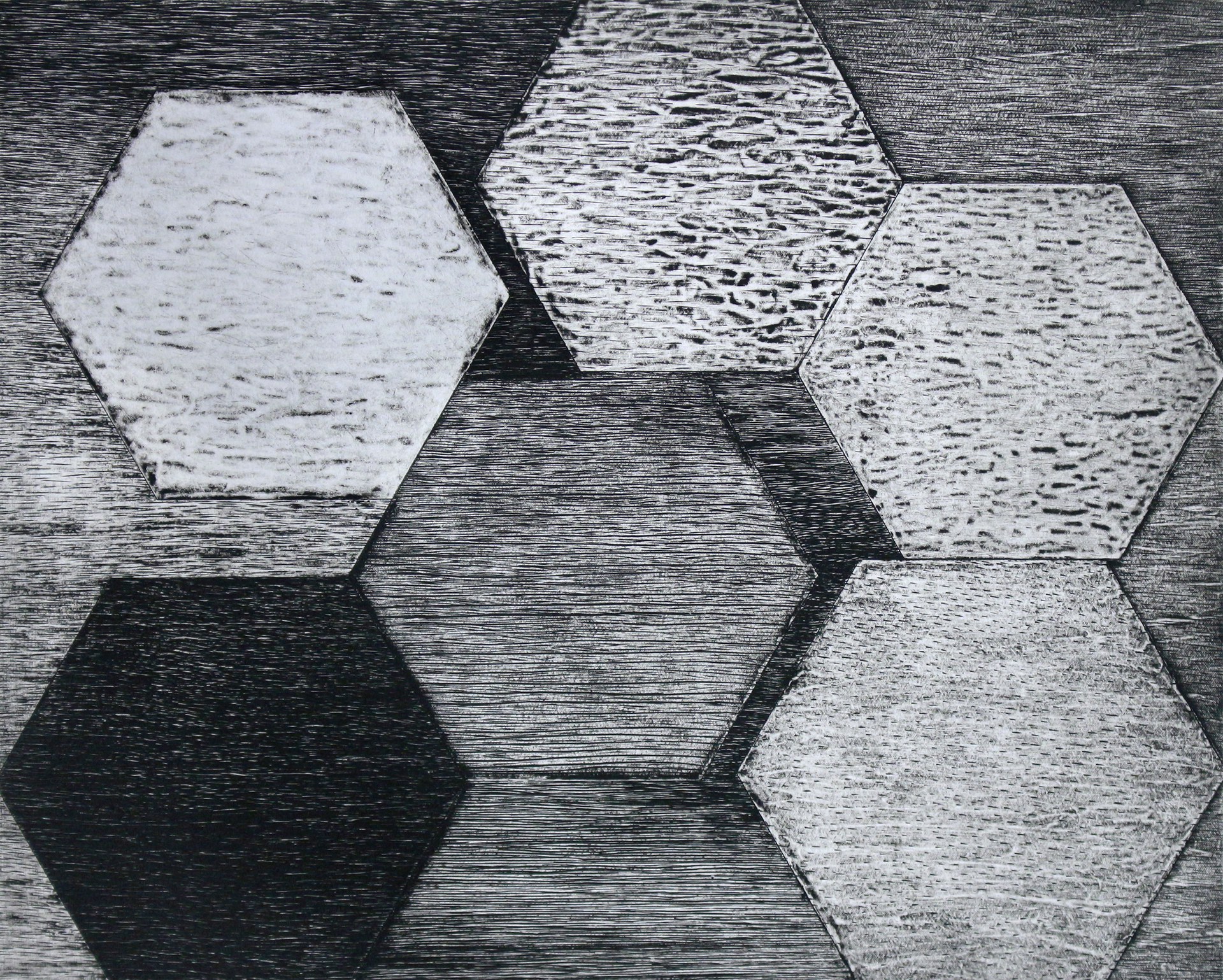
Essential Patterns of Perception: Six (6)
Laser & hand engraving, collagraph; 10” x 12.5”; 2016
The Interview
Blake Sanders: You retired in 2019 after 20 years at Iowa State and moved to Florida shortly before the initial COVID 19 lockdown. That time left many of us dazed and disoriented without the added stress of a major move and career/life change. Please share what motivated your choice to retire and what that initial hectic period was like.
April Katz: Following the spring 2018 semester, my wife and I took a trip using a Delta voucher that was about to expire. We decided to seek relaxation in a lesbian community located in Fort Myers, Florida that we had been aware of for twenty years but had never visited. We stayed in an apartment in the community’s Art House that also contained a shared studio space with a building next door that housed a gallery. There were plenty of recreational facilities; beautiful vegetation; and most importantly, a warm and welcoming community of women. We felt so much like we had “come home” that we looked at some houses and bought one that summer. This was unplanned and later that year, we realized it would be difficult to maintain both homes. Retirement marks change. In my case it wasn’t a move away from something (I truly loved the engagement of university teaching). This was a move to explore new life directions.
However, three months after the move, before all boxes had been unpacked, the pandemic began. We were incredibly fortunate to be in this nurturing community in Florida. The women came together to create support groups for each other, particularly watching out for those who were older and more vulnerable. Although indoor public spaces were closed and many of us stayed within our community and arranged to have food and other items delivered, the tropical climate of Florida allowed us all to be outside. We passed each other and conversed daily as we walked the streets in our masks. During that first year I walked endlessly, continuously photographing the spectacular clouds, sky, trees, and flowers, of this new-to-me, tropical location.
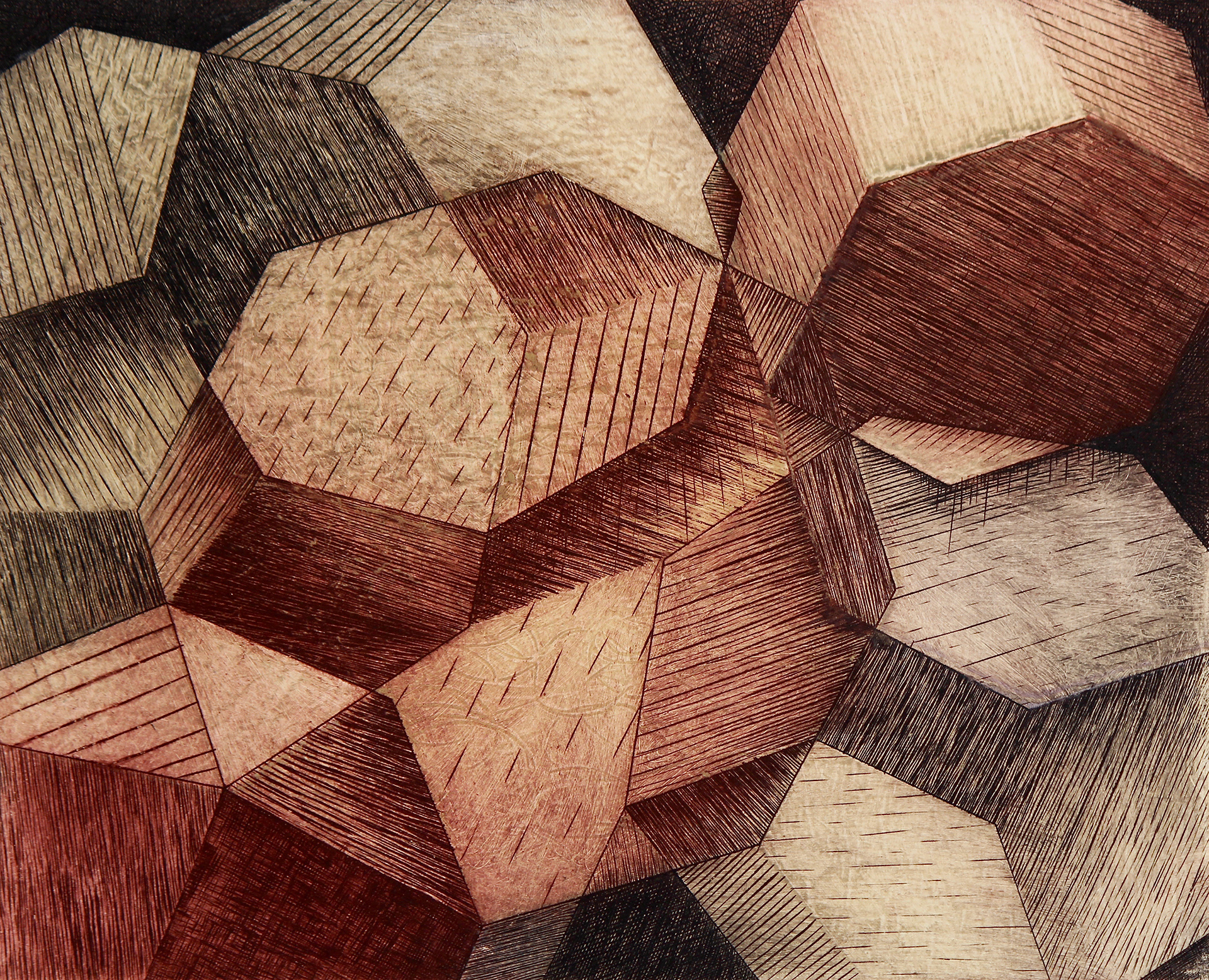
Essential Patterns of Perception: Eight (8)
Laser & hand engraving, collagraph; 10” x 12.5”; 2016
B: What is a typical, let’s say month, like for you now? Where is your studio, or where are you being creative? How regularly are you making art as you once conceived it? How has the pace/priorities of your making changed since leaving the academic expectations of creative/research output? What are your reflections on that shift?
AK: To be honest, I can’t say I have a typical month. Since leaving academe my life is more organic, less scheduled and my daily activity is more responsive to personal, family, and community needs and desires. One of the most satisfying creative endeavors I’ve engaged in is serving as chair of our community’s education committee. We bring in a diverse group of nationally known, primarily lesbian speakers from many fields in addition to those we invite from the local area. We have been able to have our programs accessible to all community members through extensive testing of available technology. This has been the avenue that best combines my experience with teaching, leadership, and creative problem solving.
Daily I’m aware of my visual environment and the political and social issues that surround me. Writing about the intersections of these observations and planning for visual responses to my world happens regularly. This has been a time to explore new directions without the pressure to build on a resume. My work has always been a way to ask questions and look for unexpected connections. This process continues.
There are several studio spaces in our new home, including a large outdoor patio area that looks out over a pond. The herons, turtles, occasional alligators, vegetation, and magnificent sky keep me engaged with this place.
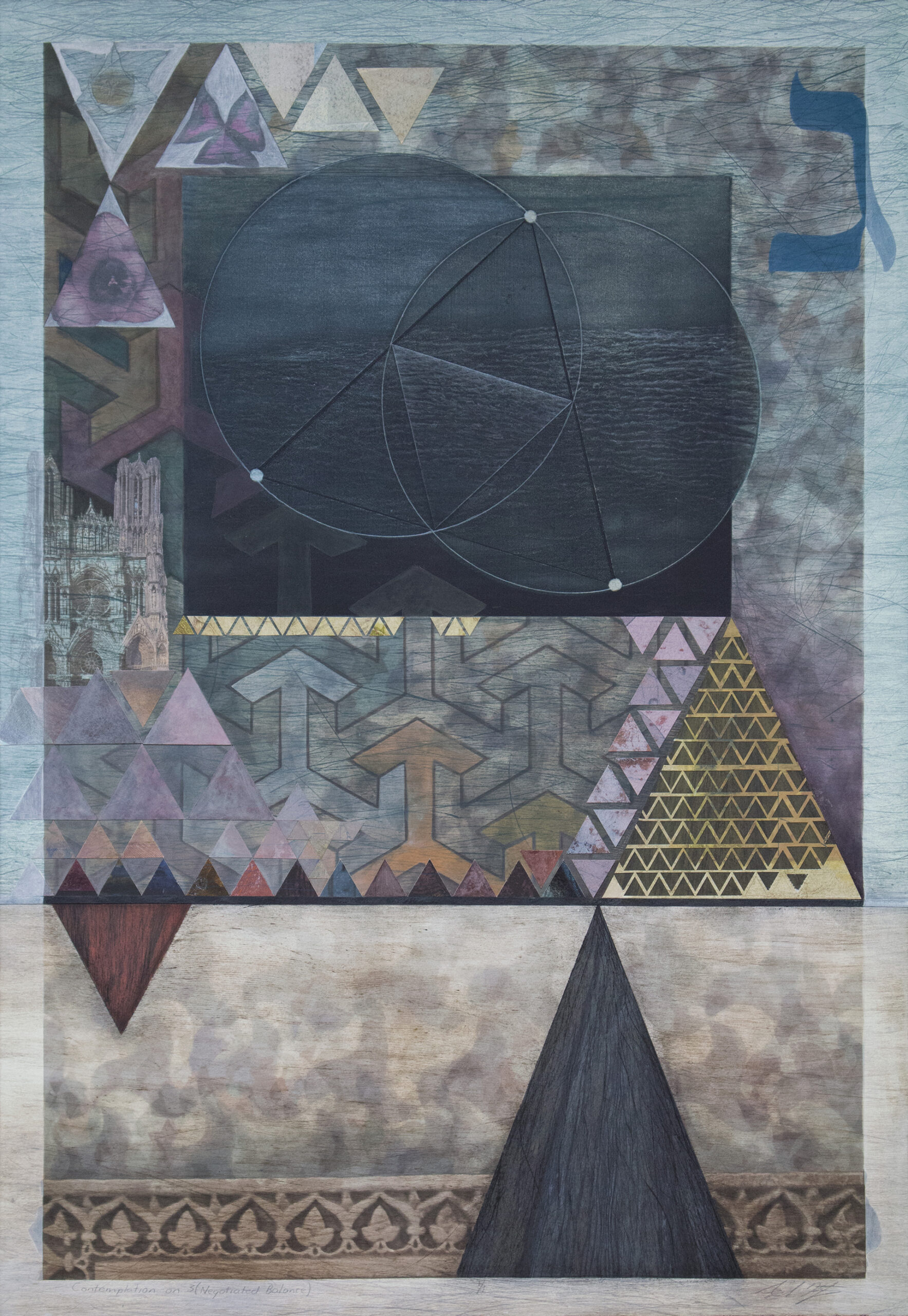
Contemplation on 3 (Negotiated Balance)
Pigmented ink jet print, etching, drypoint, aquatint, collagraph, collage, paint, pencil; 30” x 20.5”; 2019

Contemplation on 5
Pigmented ink jet print, laser & hand engraving, collagraph, collage, paint, pencil; 30” x 20.5”; 2019
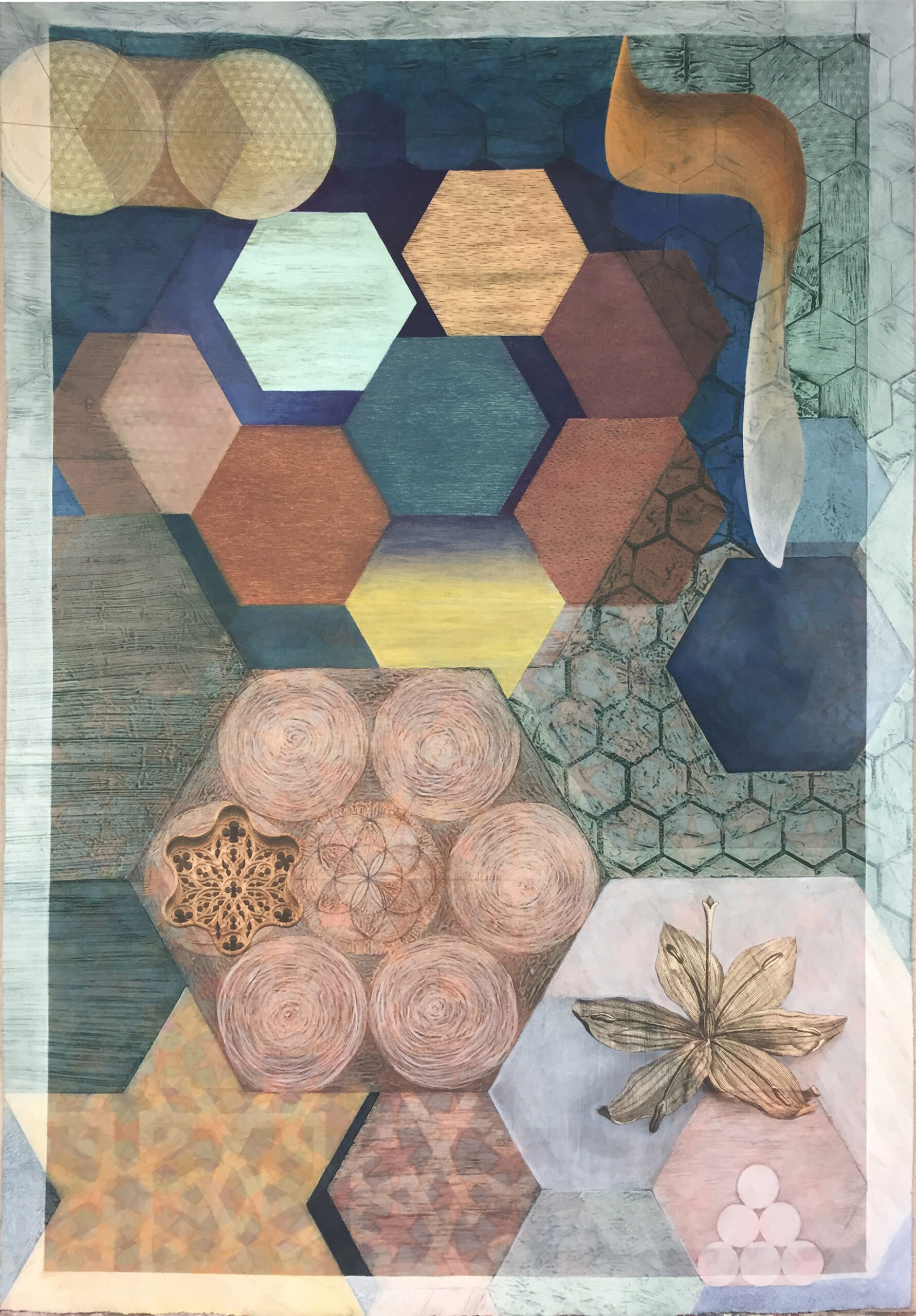
Contemplation on 6 (Sliding Into Place)
Pigmented ink jet print, laser & hand engraving, collagraph, paint; 29.5” x 20.5”; 2017
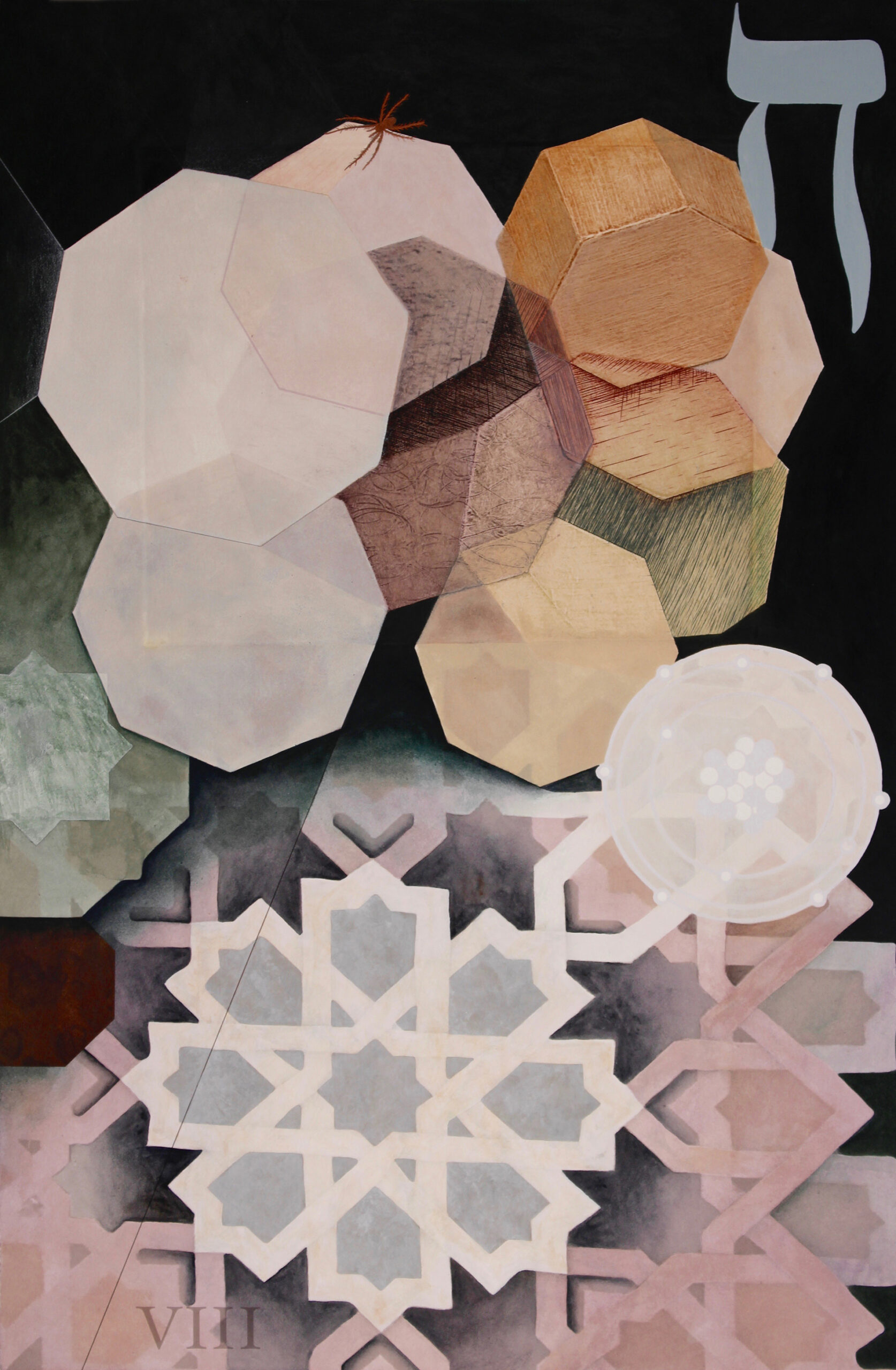
Contemplation on 8 (Web)
Pigmented ink jet print, laser & hand engraving, collagraph, paint, pencil; 28” x 18.5”; 2016
B: Looking at your research endeavors you’ve always used printmaking in conjunction with other disciplines and were an early adopter of technologies like laser engravers and CNC routers. How has that flexibility and embrace of technology allowed your practice to continue outside the friendly, well-equipped confines of the university print studio?
AK: You ask about my ongoing use of new technologies throughout my career and how the move away from the well-equipped studios of the university have impacted my work. My studio space here is significantly smaller than what I had in Iowa and doesn’t yet include a press or the advanced technologies available in the university. While I do miss the facilities and studio space I had in Iowa, I eagerly embrace whatever is available to make my work. This currently includes a Cricut cutting machine, digital printers, and of course analog media and tools.
Downsizing for the move encouraged me to look at old proofs made during four decades of printmaking. I realized I don’t need a press given my large collection of ink-on-paper…. I could recycle. After a year of photographing, I began to consider the relationship between old (prints and themes) and new (environment) and started printing digital collages of clouds and trees over old prints in a series call Memory’s Persistence. Through collage, digital printing, and paint, the prints in Memory’s Persistence convey a sense of memory. Prints from the past include images related to medical, family, and cultural factors that shaped my identity. Although I’m acclimating to this new environment, those forces are still present.
The one-of-a-kind prints I’m currently making continue my longtime embrace of the monoprint, begun in the early 1990s. In my early series called Just War, I varied the order and color of the printing elements, created stencils to block out various parts of each plate, and added collaged, drawn, and printed symbols. The process of printing became one of exploration and discovery.
The collage-a-day documentation my wife and I made during a sabbatical research trip in Europe in 1997 also had a tremendous impact on my work. When I returned home, I was drawn to the many rejected trial prints I had made for a series called Marking Time. I began to create elaborate collages of the proofs over which I printed and painted. Rather than pre-planning, this process was an intuitive building up of parts. The variety of images used in the original series of 30 small, multi-run prints enabled me to combine disparate symbols that I might not ordinarily think of putting together. This approach is evident in my current work.
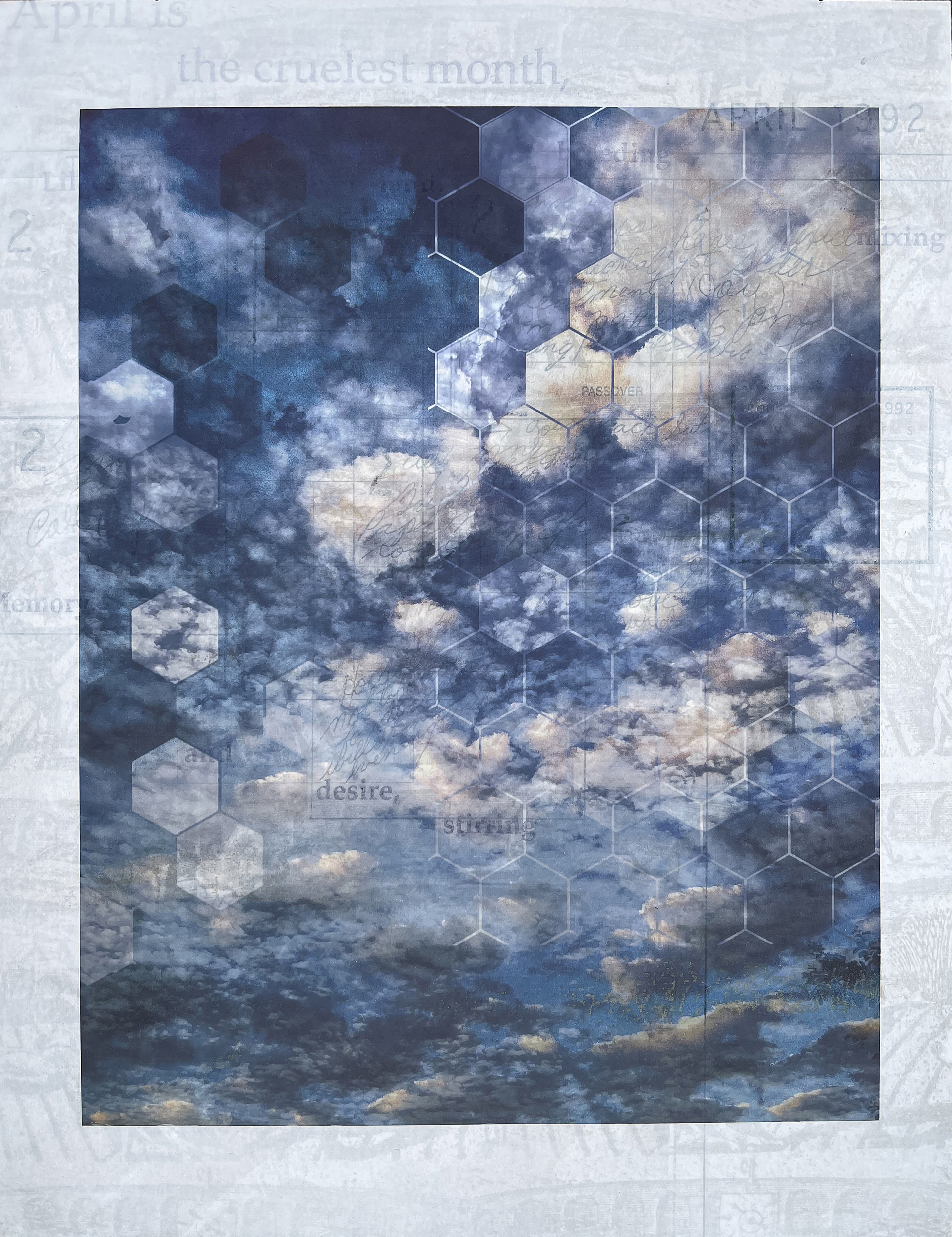
Memory’s Persistence (Cruelest Month 2)
Lithograph, intaglio, acrylic, digital print; 11″ x 8.5″; 2021
B: The work you provided for this feature is populated with hexagons and geometric motifs, beginning with pieces created for the Measured Perceptions exhibition. What is the significance of that geometry, and how does the perceived stability it provides relate to more recent work that addresses the current cultural milieu?
AK: My dad was a high school math teacher who was a warm nurturing and supportive parent. I remember my father’s fascination with the geometric order he observed in natural forms, five-petaled flowers, the cross section of an apple with its five seed chambers, and the five digits on our hands. Under his influence and as an homage to him, I began to research geometric constructions and their relationship to botanical and other natural and culturally significant forms. Throughout millennia and across the planet people count, measure, navigate, and examine the earth, seas, and sky. Mathematical observations and understanding of the environment are evident in objects created by every culture. My inquiry into this universal search for order and understanding following my father’s passing, led to Measured Perceptions made up of two related print series, Essential Patterns of Perception and Numerical Contemplations.
My understanding was enhanced during a 2015 trip to Spain where I found visually complex and beautiful geometric Islamic tiled patterns. As I continued this research, I began to recognize that within the language of mathematics and geometry there are universal truths. For instance, the geometric nature of the hexagon includes its capacity to tessellate or fit together without gaps or overlapping. Arithmetically, six is both the sum and product of one, two and three. The existence of these non-contestable mathematical truths is significant during this post-truth era. Also, while there I encountered evidence of La Convivencia (the coexistence of Muslim, Jewish and Christian populations) in Medieval Spain that provided hope for our current time of vitriolic discourse.
Measured Perceptions embraced the similarities and unique contributions of the varied cultures that follow the three Abrahamic religions and combines them with the human languages of arithmetic and geometry. The Contemplation series includes geometric intaglio plates inset within larger, mixed media monoprints that provide varied cultural and natural contexts. These prints began as digital collages that incorporated photographic and drawn imagery. Additional painting, drawing and collaged paper tesserae created rich visual layering that parallels the overlay of cultural histories found in buildings like the Mosque-Cathedral of Córdoba or the synagogue in Toledo. These prints invite meditative examination inspired by a wish for a future of peaceful coexistence, mutual respect, and meaningful dialogue.
In my more recent Florida-based series Memory’s Persistence, hexagonal patterns superimposed over the sky suggest the human gaze measuring the world and our experiences within it. The geometric elements symbolize my personal search for order and understanding.
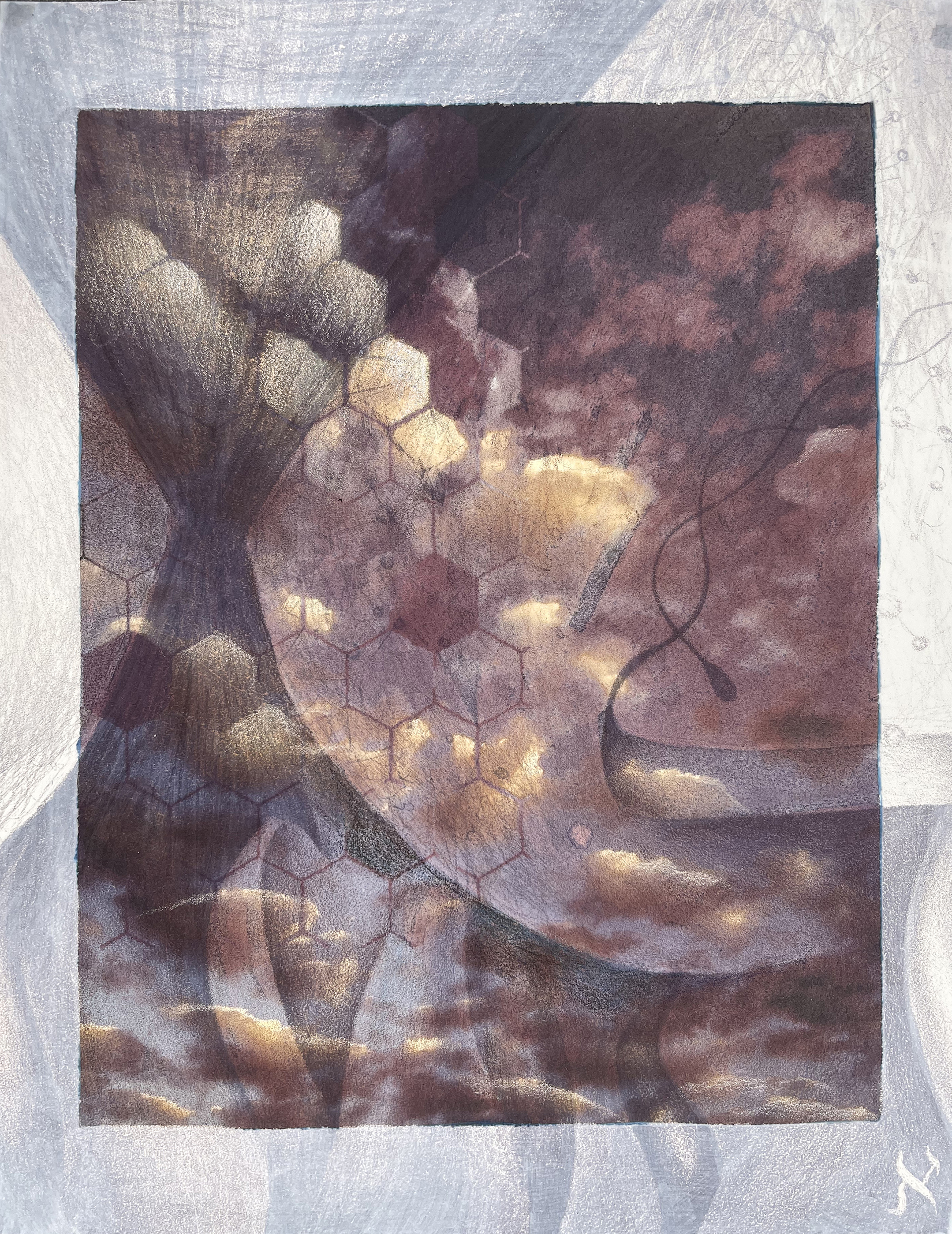
Memory’s Persistence (Aleph)
Lithograph, acrylic, digital print; 11” x 8.5”; 2021
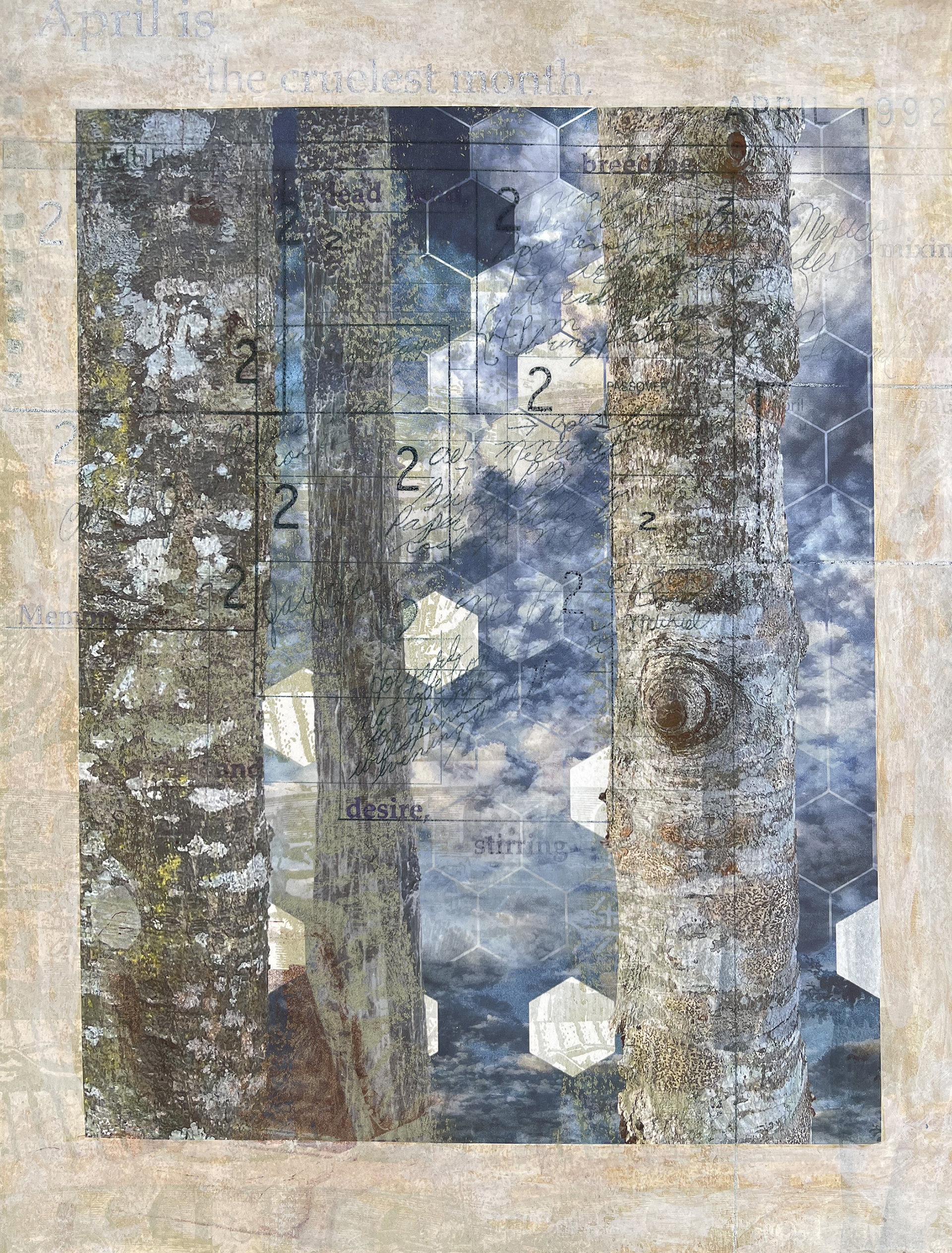
Memory’s Persistence (Cruelest Month)
Lithograph, intaglio, acrylic, digital print; 11″ x 8.5″; 2021
B: Your work has always incorporated challenges from the political to the physiological. It is fair to say that current political trends in Florida, and globally, have inspired an existential angst and anxiety in you. Despite those pressures you seem motivated to fight back on multiple fronts. How have you engaged with your community and your artwork to combat the will to turn back progress? How do these strategies differ from the way you engaged with tough topics earlier in your career?
AK: Death of loved ones, serious illness, and political discord are the forces that have shaken me to the core and led me to ask fundamental human questions about myself and my relationship to the world. My work has included responses to the death of each of my parents, my experience with breast cancer, concern over corporate ownership of genes, and the first Gulf War.
My choice to join a lesbian community began as a celebration of my identity. Now, simply living in this community is a political act. Following my retirement, national and state politics shifted the environment outside my community which is an oasis of liberalism in very conservative Lee County. I now live in a state whose governor has prohibited discussion of my identity in schools and whose libraries remove books that deal with identity justice concerns.
In response to Governor Ron DeSantis and the Florida state legislature’s Stop W.O.K.E. Act, the Parental Rights in Education Act, and additional education bills, public schools, and even colleges and universities are removing books, materials, and discussion related to race, gender, and sexual identity. The intention for my newest body of work called Banned! is to celebrate the work of these banned authors and to convey my sense that their words, ideas, and the history and lives they present persist despite these fascist laws. Visually this is an extension of my prior work with sky and hexagons. I have an essential belief that the banning of books doesn’t erase the ideas contained in them. Those ideas, the text, live on and in my recent prints, leave their mark on the environment. Eventual exhibition of these works, like my earlier prints related to breast cancer and genetics, will help to foster meaningful dialogue among viewers.
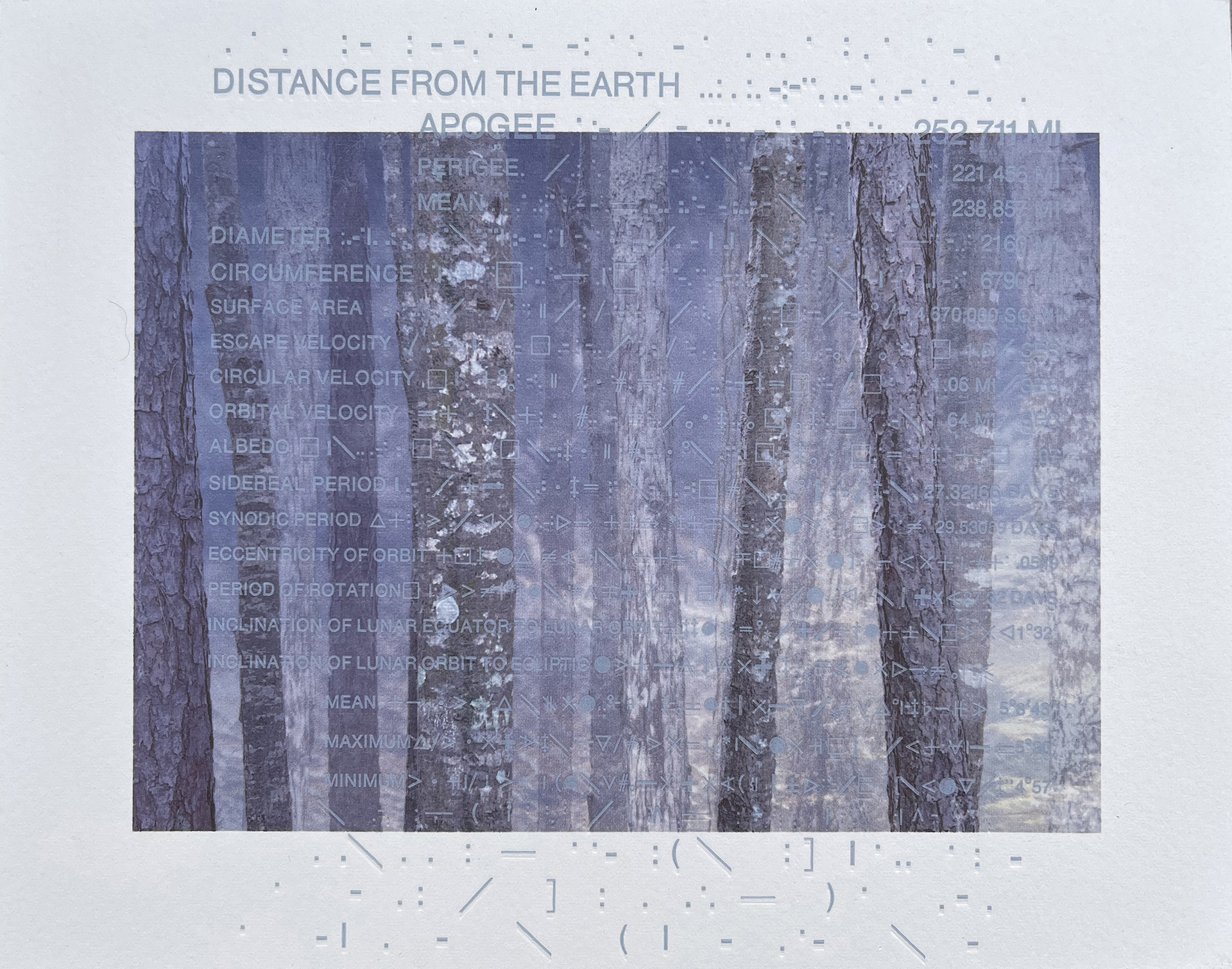
Memory’s Persistence (Distance From Earth Trees)
Lithograph, letterpress, digital print; 7″ x 9″; 2021
B: You served as Southern Graphics Council president from 2004-2006. How has involvement in SGCI and service to the national/international printmaking community affected your career? What are your thoughts on how the organization has grown since your tenure as president? Do you have any ambitions you’d like to see SGCI reach for the future? What advice do you have to the membership, especially students and those just entering the field?
AK: I encourage students and those early in their career to fully participate in this organization. When I left Arizona State University with my MFA I taught in a very isolated, rural community in western Pennsylvania. I left a dynamic and engaged printmaking community with excellent facilities to a college with minimal equipment where I was the only printmaker. My involvement in the Southern Graphic Council as panelist, panel chair, technical demonstrator, mentor, vice-president, and president provided some of the most meaningful professional opportunities and relationships of my career. Those experiences helped to build my confidence and leadership skills. I experienced sheer joy at being with others who understood my passion for ink on paper and who willingly shared their knowledge and skills. Those annual SGC conferences were a lifeline for me. The more you give to it, the more you’ll grow and make important connections.
The most important suggestion I have for SGCI is to continue to expand inclusivity. Welcome the youngest printmakers who will have an eye towards the future, perhaps break rules, and provide innovative approaches. Embrace those closer to the end of their careers to help us remember our history, share knowledge, and provide guidance. Include those from different backgrounds. It is in the open sharing of our varied viewpoints and lives that we will remain a dynamic and sustainable organization.
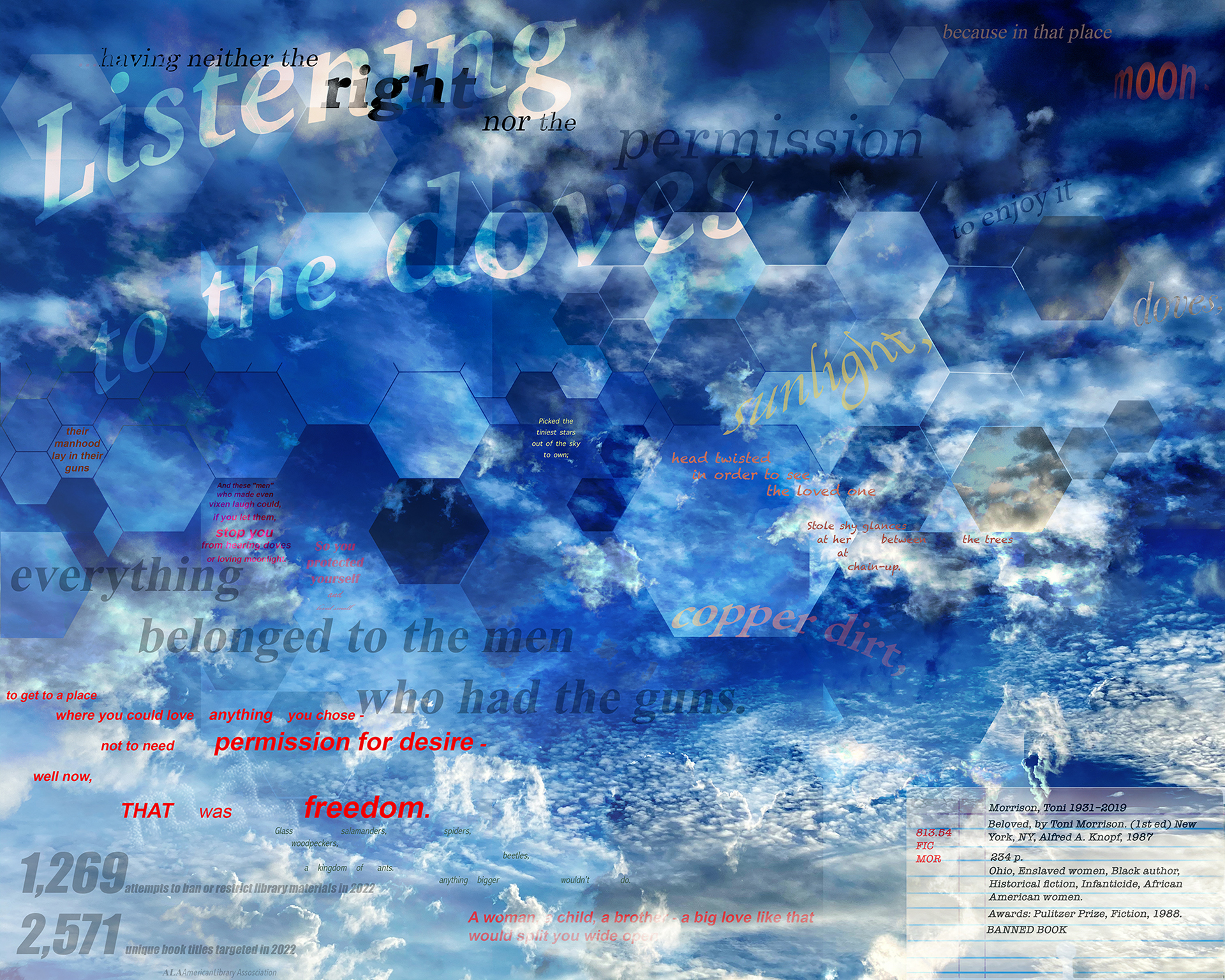
BANNED! Beloved, Toni Morrison
Pigmented ink jet print; 20” x 16”; 2023

